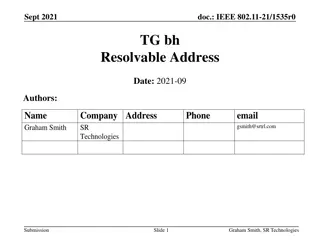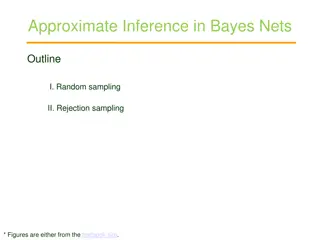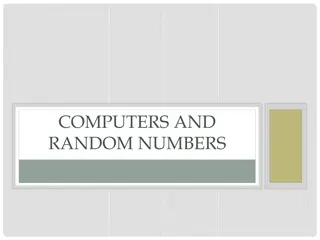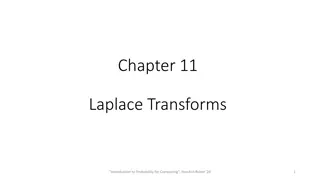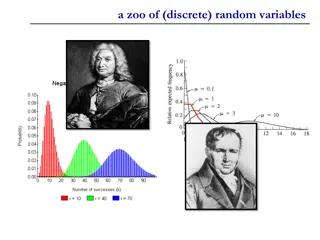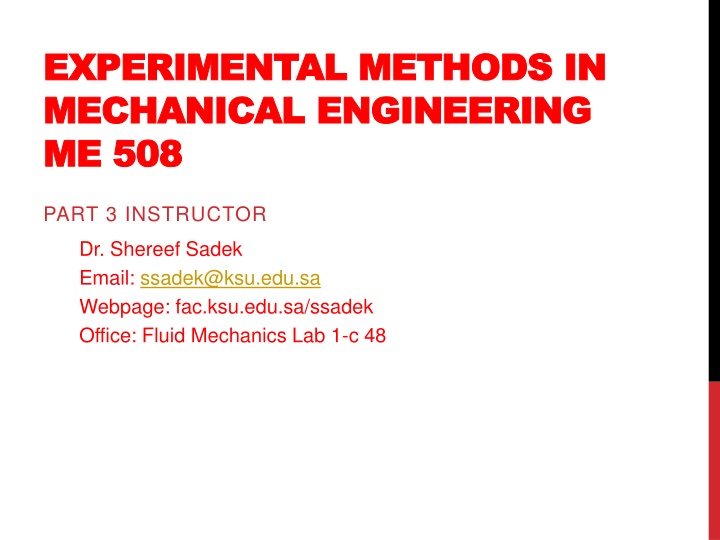
Deterministic and Non-Deterministic Data in Mechanical Engineering
Explore the concepts of deterministic and non-deterministic data in the field of mechanical engineering. Learn how to classify data, differentiate between types of physical variables, and understand the implications for experimental methods. Get insights into the application of random signals in mechanical engineering experiments.
Download Presentation

Please find below an Image/Link to download the presentation.
The content on the website is provided AS IS for your information and personal use only. It may not be sold, licensed, or shared on other websites without obtaining consent from the author. If you encounter any issues during the download, it is possible that the publisher has removed the file from their server.
You are allowed to download the files provided on this website for personal or commercial use, subject to the condition that they are used lawfully. All files are the property of their respective owners.
The content on the website is provided AS IS for your information and personal use only. It may not be sold, licensed, or shared on other websites without obtaining consent from the author.
E N D
Presentation Transcript
EXPERIMENTAL METHODS IN EXPERIMENTAL METHODS IN MECHANICAL MECHANICAL ENGINEERING ENGINEERING ME 508 ME 508 PART 3 INSTRUCTOR Dr. Shereef Sadek Email: ssadek@ksu.edu.sa Webpage: fac.ksu.edu.sa/ssadek Office: Fluid Mechanics Lab 1-c 48
EXPERIMENTAL METHODS IN EXPERIMENTAL METHODS IN MECHANICAL ENGINEERING MECHANICAL ENGINEERING Part 3 outline: Random Data Analysis 1. Random Signal Analysis: Time domain analysis; RMS,Probability density function, Auto and Cross correlation function. Frequency domain analysis; Power spectrum, power spectral density, Cross spectral density. Digital Data Processing: Filtering and digital sampling; Windowing, FFT and aliasing. Introduction to Data Acquisition Systems: LABVIEW and ELVIS Application of Random Signals in Mechanical Engineering 2. 3. 4. 3/19/2025 2 ME 508 Experimental Methods in mechanical Engineering
BASIC DESCRIPTIONS OF PHYSICAL DATA Deterministic, Non-Deterministic Data In all engineering fields we observe different kinds of physical variables Sometimes we can predict accurately the behavior through explicit mathematical formulation and sometimes we can t. We can classify data as being Deterministic or non-Deterministic. Deterministic data are those quantities that we can predict at any time using explicit mathematical formulation. Example: vibration of a mass-spring system ? ?? ? ? = ?cos ,? ? Non-Deterministic data can not be predicted using an explicit mathematical formulation. Example: amplitude of ocean waves, acoustic pressure variation, instantaneous flow velocity in a pipe. Non-Deterministic data must be described in terms of probability statements and statistical averages. 3/19/2025 3 ME 508 Experimental Methods in mechanical Engineering
BASIC DESCRIPTIONS OF PHYSICAL DATA In general if a controlled experiment is repeated multiple times and the data of interest is the same (within experimental uncertainty) then this data is deterministic. If we can not design an experiment such that the repeated result is the same, then this data must be treated as random. Classification of Deterministic Data Periodic Simple Harmonic (Sinusoidal) Data Complex Periodic Data Non-Periodic Almost Periodic Transient 3/19/2025 4 ME 508 Experimental Methods in mechanical Engineering
BASIC DESCRIPTIONS OF PHYSICAL DATA Classification of Deterministic Data Simple Harmonic (Sinusoidal) Simple harmonic functions are time varying functions that can be written mathematically as, ? ? = ?sin 2??0? + ? Where, ? = ????????? ?0= ?????? ????????? ?? ?? (?????? ?? ????? ??? ??????) ? = ??????? ? ??? ????? ??? ??????? ?? ???? ?????? ?? ??????? ? ? = ????????????? ????? ?? ???? ? 1 ?0. The time taken for one full cycle is called Period , ? = We can either plot the time history of the function x or plot the amplitude of oscillation versus the frequency (Frequency Spectrum). 3/19/2025 5 ME 508 Experimental Methods in mechanical Engineering
BASIC DESCRIPTIONS OF PHYSICAL DATA Classification of Deterministic Data Time History Frequency Spectrum ? = 0.8,? =? 4???,?0= 0.477 ?? 3/19/2025 6 ME 508 Experimental Methods in mechanical Engineering
BASIC DESCRIPTIONS OF PHYSICAL DATA Complex Periodic Data Complex periodic data are those data type that can be represented mathematically by a time-varying function whose waveform repeats itself exactly every period of time T. This is represented as, ? ? = ? ? ?? , Unlike simple periodic data, complex periodic data have more than one frequency. The smallest frequency is called the fundamental frequency, ?1. Complex Periodic data can be represented mathematically through Fourier series such that, ? ? =?0 2+ ?=1 ? = 1,2,3, ??cos2???1? + ??sin2???1? 3/19/2025 7 ME 508 Experimental Methods in mechanical Engineering
BASIC DESCRIPTIONS OF PHYSICAL DATA Complex Periodic Data Where ?1= ? ??=1 1 ? ? ?(?)cos 2??1?? ?? ? = 0,1,2, 0 ? ??=1 ? ?(?)sin 2??1?? ?? ? = 1,2,3, 0 We can write the Fourier series in terms of sine or cosine functions only as follows, ? ? = ?0+ ??cos 2???1? ?? ?=1 Where ?0=?0 2 2+ ?? 2, ??= ?? ? = 1,2,3, ??= tan ?? ??, ? = 1,2,3, 3/19/2025 8 ME 508 Experimental Methods in mechanical Engineering
BASIC DESCRIPTIONS OF PHYSICAL DATA Complex Periodic Data ? ? = 2cos2?? + 0.2cos4?? + 0.4cos6?? + 0.1cos10?? Period ? = 1 ???. Fundamental frequency ? = 2? ???/??? 3/19/2025 9 ME 508 Experimental Methods in mechanical Engineering
BASIC DESCRIPTIONS OF PHYSICAL DATA Complex Periodic Data Frequency Spectrum ? ? = 2cos2?? + 0.2cos4?? + 0.4cos6?? + 0.1cos10?? Frequencies: ?1= 1 ??,?2= 2 ??,?3= 3 ??,?4= 5 ?? 10 3/19/2025 ME 508 Experimental Methods in mechanical Engineering
BASIC DESCRIPTIONS OF PHYSICAL DATA Almost Periodic Data Complex data can be represented as a sum of simple harmonic relations whose frequencies are related (integer factor) On the other-hand if simple harmonic relations are summed whose frequencies are not related (arbitrary frequencies e.g. ?1= 1 ??,?2= 7 ??) then the resulting data will not be periodic in general. In general if the ratio of all possible pair of frequencies form a rational number then the sum of those waves will be periodic. ? ? = 2cos4?? + 0.2cos6?? + 0.4cos14?? The frequency ratios are 2 3and 2 7 and 3 7. 11 3/19/2025 ME 508 Experimental Methods in mechanical Engineering
BASIC DESCRIPTIONS OF PHYSICAL DATA Almost Periodic Data ? ? = 2cos4?? + 0.2cos6?? + 0.4cos2 50?? 12 3/19/2025 ME 508 Experimental Methods in mechanical Engineering
BASIC DESCRIPTIONS OF PHYSICAL DATA Almost Periodic Data Almost periodic ? ? = 2cos4?? + 0.2cos6?? + 0.4cos2 50?? Periodic ? ? = 2cos4?? + 0.2cos6?? + 0.4cos14?? 13 3/19/2025 ME 508 Experimental Methods in mechanical Engineering


